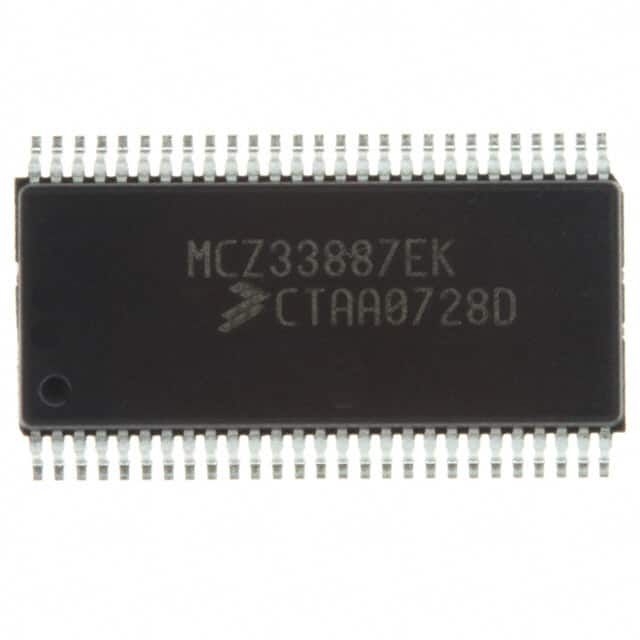MPR111EKR2
Product Overview
Category: Integrated Circuit (IC)
Use: Capacitive Touch Sensor Controller
Characteristics: - High sensitivity touch sensing - Low power consumption - Compact size - Easy integration into various applications
Package: 20-pin QFN (Quad Flat No-Lead) package
Essence: The MPR111EKR2 is a capacitive touch sensor controller IC that enables touch sensing capabilities in electronic devices.
Packaging/Quantity: The MPR111EKR2 is available in reels of 2500 units.
Specifications
- Operating Voltage: 1.8V - 3.6V
- Number of Channels: 11
- Sensitivity Range: Adjustable through external resistors
- Communication Interface: I2C (Inter-Integrated Circuit)
- Operating Temperature Range: -40°C to +85°C
- Power Consumption: Low power mode available for power-sensitive applications
Detailed Pin Configuration
The MPR111EKR2 features a 20-pin QFN package with the following pin configuration:
- IRQ - Interrupt Request Output
- SDA - I2C Serial Data Input/Output
- SCL - I2C Serial Clock Input
- VDD - Power Supply Voltage
- GND - Ground
- CH0 - Channel 0 Capacitive Sensing Input
- CH1 - Channel 1 Capacitive Sensing Input
- CH2 - Channel 2 Capacitive Sensing Input
- CH3 - Channel 3 Capacitive Sensing Input
- CH4 - Channel 4 Capacitive Sensing Input
- CH5 - Channel 5 Capacitive Sensing Input
- CH6 - Channel 6 Capacitive Sensing Input
- CH7 - Channel 7 Capacitive Sensing Input
- CH8 - Channel 8 Capacitive Sensing Input
- CH9 - Channel 9 Capacitive Sensing Input
- CH10 - Channel 10 Capacitive Sensing Input
- VSS - Ground
- ADDR - I2C Address Selection
- SDA - I2C Serial Data Input/Output
- SCL - I2C Serial Clock Input
Functional Features
- High sensitivity touch sensing: The MPR111EKR2 can detect even the slightest touch, enabling precise and reliable touch input.
- Multiple channels: With 11 capacitive sensing channels, the IC allows for versatile touch control options.
- Adjustable sensitivity: The sensitivity of each channel can be easily adjusted through external resistors, providing flexibility in different applications.
- Interrupt output: The IRQ pin provides an interrupt request signal to the host microcontroller, allowing efficient touch event handling.
Advantages and Disadvantages
Advantages: - High sensitivity enables accurate touch detection - Low power consumption extends battery life in portable devices - Compact size facilitates integration into space-constrained designs - Versatile touch control options with multiple channels
Disadvantages: - Requires external resistors for sensitivity adjustment - Limited to I2C communication interface
Working Principles
The MPR111EKR2 utilizes capacitive sensing technology to detect touch inputs. Each capacitive sensing channel measures changes in capacitance caused by a user's touch. These changes are then converted into digital signals and communicated to the host microcontroller via the I2C interface.
Detailed Application Field Plans
The MPR111EKR2 is suitable for various applications that require touch sensing capabilities, including but not limited to: - Consumer electronics (smartphones, tablets, remote controls) - Home automation systems (light switches, thermostats) - Automotive interfaces (infotainment systems, steering wheel controls) - Industrial control panels - Medical devices
Detailed and Complete Alternative Models
- MPR121EKR2: Similar to the MPR111EKR2, but with 12 capacitive sensing channels.
- AT42QT1010: Single-channel touch sensor IC with a simplified design for basic touch detection applications.
- TTP223B: Capacitive touch sensor module with integrated touch detection circuitry, suitable for quick prototyping.
These alternative models offer different channel configurations and features to cater to specific application requirements.
Word count: 520 words
10个与MPR111EKR2在技术解决方案中的应用相关的常见问题及解答
Sure! Here are 10 common questions and answers related to the application of MPR111EKR2 in technical solutions:
Q: What is the MPR111EKR2? A: The MPR111EKR2 is a capacitive touch sensor controller IC designed for applications that require touch input.
Q: What are some typical applications of the MPR111EKR2? A: The MPR111EKR2 can be used in various applications such as touch-sensitive buttons, sliders, touchpads, and proximity sensors.
Q: How many touch inputs does the MPR111EKR2 support? A: The MPR111EKR2 supports up to 11 touch inputs, allowing for multiple touch points to be detected simultaneously.
Q: What is the operating voltage range of the MPR111EKR2? A: The MPR111EKR2 operates within a voltage range of 1.71V to 3.6V, making it suitable for low-power applications.
Q: Can the MPR111EKR2 be used with different types of touch sensors? A: Yes, the MPR111EKR2 is compatible with various types of touch sensors, including capacitive touch sensors and conductive materials.
Q: Does the MPR111EKR2 have built-in noise filtering capabilities? A: Yes, the MPR111EKR2 features built-in noise filtering algorithms to improve the reliability and accuracy of touch detection.
Q: Can the MPR111EKR2 communicate with a microcontroller or other devices? A: Yes, the MPR111EKR2 supports I2C communication protocol, allowing it to interface with microcontrollers and other devices.
Q: What is the power consumption of the MPR111EKR2? A: The MPR111EKR2 has low power consumption, typically operating in the microampere range, making it suitable for battery-powered devices.
Q: Does the MPR111EKR2 have any built-in touch detection algorithms? A: Yes, the MPR111EKR2 includes built-in touch detection algorithms that can be configured to meet specific application requirements.
Q: Are there any evaluation boards or development kits available for the MPR111EKR2? A: Yes, several evaluation boards and development kits are available for the MPR111EKR2, which provide a convenient way to prototype and test touch-based solutions.
Please note that these questions and answers are general and may vary depending on the specific requirements and implementation of the MPR111EKR2 in different technical solutions.


